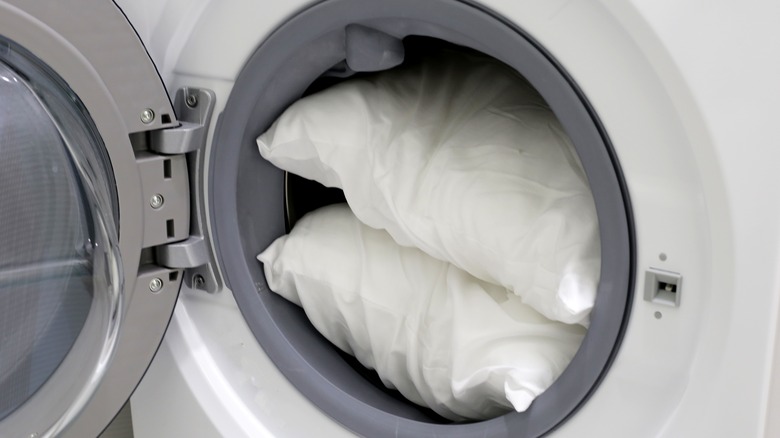Why You Should Consider Stuffing Your Pillows Into The Freezer
If you've noticed yellow stains on your pillows or are experiencing allergic reactions, you may be dealing with dust mites. Don't panic, though, because your freezer is here with a simple and effective solution. Apparently, keeping affected pillows in a freezer for two days kills mites and prevents their eggs from hatching in the future.
For a 2017 study published in The Journal of Allergy and Clinical Immunology, scientists placed a sample of one kind of dust mite (Dermatophagoides farinae) and their eggs in freezing conditions. In a freezer set to -15 degrees Celsius, or 5 degrees Fahrenheit, in as little as 48 hours, the mites and their eggs died. The same study didn't look into the other common dust mite (Dermatophagoides pteronyssinus), however, the authors pointed out that in previous studies, samples of those mites exposed to the same temperature died within 30 minutes.
In other words, placing a pillow affected by either kind of dust mite in a freezer set to 5 degrees Fahrenheit for two days is enough to kill them. That said, there are some things you'll want to keep in mind when putting this study into practice in your own home.
Temperature and timing are super important
Let's delve into temperatures and timing. The Journal of Allergy and Clinical Immunology study used 5 degrees Fahrenheit for their experiment, because that's generally what home freezers are set to. If yours is set to an even lower temperature, you should have the same results. The study found that even -12 degrees Celsius, or 10 degrees Fahrenheit, will kill most mites. However, it's important not to go any warmer than that. The study found that 24 hours at -4 degrees Celsius, or 24 degrees Fahrenheit, was enough for mites to not only survive, but lay viable eggs. For best results, play on the safe side, and stick with 5 degrees Fahrenheit.
As for the timing, the study found that even one day is enough to kill most mites within two weeks of the freeze — the vast majority of the eggs in the study were unviable after a day. That said, keeping your pillows in the freezer for less than two days in the hopes of speeding up the process is counterintuitive. For starters, even if most of the mites are likely to die, you'd still be sleeping on them for up to two weeks in the meantime. Plus, while the odds are pretty slim, there is a chance some of the eggs could hatch. That's not particularly appealing, so stick with the suggested two-day freeze.
You will still need to wash your pillows
Unfortunately for anyone hoping this hack ends with a mite-free and gloriously cold pillow, the process doesn't end once the pillow comes out of the freezer. As noted by the authors of the study, your pillow still needs to be washed following the freeze. That's because even if the mites are already dead, their remnants may still cause allergic reactions.
To really ensure your pillows are free from any traces of the mites, give them a deep clean using household staples baking soda, borax, and laundry detergent. That should be enough to get rid of the offending allergens and any dirt attracting the mites in the first place. Granted, if your pillows are feather-based, you should forego this mixture and use a down-specific detergent instead.
All that's left to do, once your pillows have been frozen and laundered, is to make sure mites don't return. Wash your bedding regularly and be sure to dust and vacuum the surrounding areas, too. You could also take things a step further and keep mites away using an all-natural DIY eucalyptus oil spray that you spritz onto your bedding weekly. On the off chance that these common laundry allergens return at some point, it's great to know that a two-day stint in your freezer is an effective first step.


